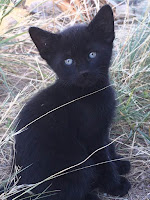"The Mind Readers." This was the headline over a fascinating two-page article in today's New York Times, a discussion of recent developments in scientists' ability to read and use the thoughts of a person as they appear in his brain, and -- moreover -- to control those thoughts from the outside.
Our ability to do so is still rudimentary, but impressive. For example, some victims of disease or accident with damaged motor nerves are unable to move an arm or leg. Scientists are able to decode blocked messages from the brain instructing muscles to move the limb, and can now wire a signal directly to the intended muscles. The person desires to move his arm, and, yes, the arm moves -- exactly as it would in an uninjured person. It's only one step further to hook up a prosthesis that has replaced an amputated limb, and to enable it to respond to the same signals
Patients who have lost the ability to speak, say from a stroke, while still remaining cognitively intact, can be connected to an artificial speaker, like Alexa's, and "speak" the words that their brain tries unsuccessfully to make the mouth speak. More prosaically, the author notes that we already are able to control drones by brain signals.
The article projects far more extraordinary abilities that we may develop in the future, both to control our environment merely by brain signals, and to receive information directly into our brains without using eyes or ears as intermediaries. The article also discusses at some length the ethical and legal dilemmas that may soon arise. Do we really want to allow Google to tell our brains that we have an irresistible craving for an advertiser's candy?
While reading, my own mind was applying some of the developments discussed in the article to my own pathetically parochial interests. Primarily, my two new kittens.
One obvious difference between a dog and a cat is transparency. A dog would never make a good poker player -- not with that wagging tail, drooling tongue, panting breath, and big happy grin. A cat, on the other hand, could look you straight in the eye and bluff a pair of nines into a winning hand. You never know what's going on in their heads.
My kittens aren't even teenagers yet, in cat years. They have no conscious secrets or desire to deceive. (Or do they?) But I'm almost convinced that the word "inscrutable" somehow shares a common etymological ancestor with the word "cat."
They will be wrestling on the floor, seemingly oblivious to me, that guy in the chair reading a book. And then one of them will glance over at me, appearing to check out whether I'm watching them. As though their little tussle is an act put on for my amusement. With an older cat, I've looked up from my reading to see him sitting on the arm of my chair, staring at me, studying me. What's he doing? What's he thinking about?
When a human is so bored or tired that he "stops thinking," just staring off into space, his brain is still quite active -- thinking, even if not consciously, about plans for tomorrow, maybe worrying what his boss meant by that possibly insulting comment as he left the office. But they've run EEGs on cats -- yes, honestly, they have! -- and discovered that when a cat stares off into space, his brain wave goes totally flat. He is essentially, if temporarily, brain dead.
I'd love to read their minds. Are they constantly conscious of me and my reactions to their wild activities? Do they stare at me, trying to read my mind? What happens to their thoughts as their brain wave flattens -- is it like listening to HAL's voice as he/it dies, in 2001 Space Odyssey?
Are they happy to see me? Or is their apparent happiness ironic? Do they look at each other and roll their eyes when my back is turned?
These would be wonderful things to learn. On the other hand, why do I love cats? Isn't it because they are so often mysterious? So unlike a dog? Do I really want to know their every thought? Wouldn't it really be like discovering that the sophisticated woman you find so enchanting -- loving, but always mysterious -- actually spends the time away from you watching daytime TV, and says so little because she has so little to say?
The New York Times writer anticipates my concern, if not my cats:
Not even Dr. Gallant, who first succeeded in translating neural activity into a moving image of what another person was seeing -- and who was both elated and horrified by the exercise -- thinks the Luddite approach is an option. "The only way out of the technology-driven hole we're in is more technology and science," he told me. "That's just the cool fact of life."
Well, I'll leave it to the next generation to worry about. My own cats will remain enchanting and mysterious.



















